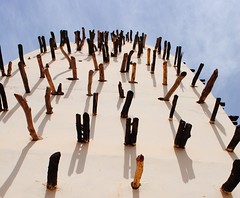From his peaceful pocket of Bamako Waou answered my question, “you want to build a ngoni? It’s very hard!”.
With a little convincing he patiently showed me how to hand build an ngoni, the grandfather of the banjo.

Step 1: Taking a large tree trunk we chopped a log to the rough size of my future ngoni’s body.

Step 2: Putting down our axes we carved out the inside to make a canoe shape and then sanded its rough surface.



Step 3: Then we drilled about 16 holes around the edge of the body before creating a groove at one end for the neck to lay.
Step 4: Cutting bamboo poles we made around 20 wooden nails.
Step 5: Then for the smelly job, we sliced the cow skin (which had soaked overnight) to the shape of the body.
Step 6: Using the bamboo nails, we stretched the skin across the body and pinned it into place.

Step 7: Using a chisel tool we carved the neck to the shape of a broom handle with a spike at one end. We then cut holes into the skin and inserted the neck of the instrument.

Step 8: We then left the whole thing to dry in the blistering 42 degree heat of the Malian sunshine. With the scorching sunshine the skin-drying only takes a few hours!

Step 9: Using a hack saw we cut off the bamboo pins to the body.
Step 10: The instrument finished, we moved onto the strings…
“What was used before nylon fishing line was available?” I ask.
“Horse hair” explains Waou, his eyes scarcely stray from his work. Remembering a story of European violin players having to hunt down cats to make strings from their guts, I tell Waou that his ancestors were far more civilised than their European counterparts.


Waou attaches a string to the neck
After attaching all the strings to the instrument (six in this case), he proudly checks it over, fine tunes it and gives it a play. It is difficult to imagine that a day earlier it was little more that a log of wood, a fragment of calabash, some cow skin and a few metres of fishing line…
For all the photos, click here.
51.547058
-0.113223















